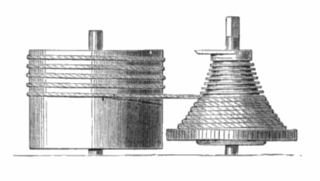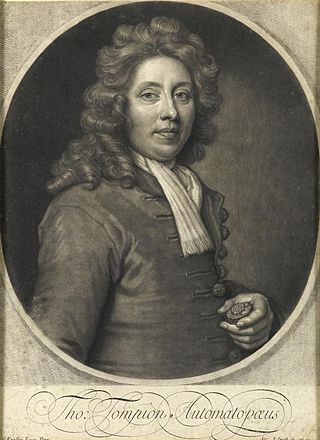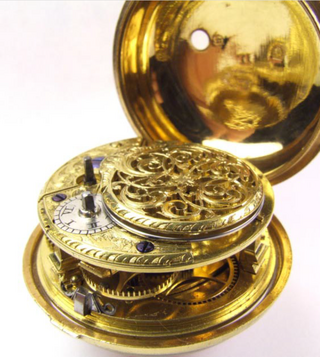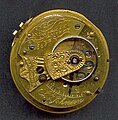
A watchmaker is an artisan who makes and repairs watches. Since a majority of watches are now factory-made, most modern watchmakers only repair watches. However, originally they were master craftsmen who built watches, including all their parts, by hand. Modern watchmakers, when required to repair older watches, for which replacement parts may not be available, must have fabrication skills, and can typically manufacture replacements for many of the parts found in a watch. The term clockmaker refers to an equivalent occupation specializing in clocks.
Henry Hindley (1701–1771) was an 18th-century clockmaker, watchmaker and maker of scientific instruments. He invented a screw-cutting lathe, a fusee-cutting engine and an improved wheel-cutting engine and made one of the first dividing engines, for the construction of accurately-graduated arcs on scientific instruments. He is thought to have made the world's first equatorially-mounted telescope, which can now be seen in Burton Constable Hall in East Yorkshire.

A clockmaker is an artisan who makes and/or repairs clocks. Since almost all clocks are now factory-made, most modern clockmakers only repair clocks. Modern clockmakers may be employed by jewellers, antique shops, and places devoted strictly to repairing clocks and watches. Clockmakers must be able to read blueprints and instructions for numerous types of clocks and time pieces that vary from antique clocks to modern time pieces in order to fix and make clocks or watches. The trade requires fine motor coordination as clockmakers must frequently work on devices with small gears and fine machinery.

John Arnold was an English watchmaker and inventor.

A fusee is a cone-shaped pulley with a helical groove around it, wound with a cord or chain attached to the mainspring barrel of antique mechanical watches and clocks. It was used from the 15th century to the early 20th century to improve timekeeping by equalizing the uneven pull of the mainspring as it ran down. Gawaine Baillie stated of the fusee, "Perhaps no problem in mechanics has ever been solved so simply and so perfectly."

The Clockmakers’ Museum in London, England, is believed to be the oldest collection specifically of clocks and watches in the world. The collection belongs to and is administered by the Clockmakers’ Charity, affiliated to the Worshipful Company of Clockmakers, founded in 1631 by Royal Charter. Since 2015 it has been housed in a gallery provided by the Science Museum in South Kensington, having formerly been located in the Guildhall complex in the City of London since 1874, where it first opened to the public. Admission is free.

Thomas Tompion, FRS (1639–1713) was an English clockmaker, watchmaker and mechanician who is still regarded to this day as the "Father of English Clockmaking". Tompion's work includes some of the most historic and important clocks and watches in the world, and can command very high prices whenever outstanding examples appear at auction. A plaque commemorates the house he shared on Fleet Street in London with his equally famous pupil and successor George Graham.

The American Watchmakers-Clockmakers Institute (AWCI) is a not-for-profit trade association based in the United States that is dedicated to the advancement of the modern watch industry, from which it receives a significant portion of its funding. While the AWCI is an American organization, it also has members throughout the world.

The Federation of the Swiss Watch Industry (FH) is the Swiss watch industry's leading trade association, headquartered in Bienne, Switzerland. The Federation is a private, professional and non-profit association.

Thomas Mudge was an English horologist who invented the lever escapement, a technological improvement to the pocket watch.

Gallet (ˈgæl.eɪ) is a historic Swiss manufacturer of high-end timepieces for professional, military, sports, racing, and aviation use. Gallet is the world's oldest clock making house with history dating back to Humbertus Gallet, a clock maker who became a citizen of Geneva in 1466. It is one of the oldest continuously operating companies in the World. The Gallet & Cie name was officially registered by Julien Gallet (1806–1849) in 1826, who moved the family business from Geneva to La Chaux-de-Fonds, Switzerland. Prior to this date, operations commenced under the name of each of the Gallet family patriarchs.

Jean-Antoine Lépine was a French watchmaker. He contributed inventions which are still used in watchmaking today and was amongst the finest French watchmakers, who were contemporary world leaders in the field.
Sant Blanc is a family owned watch and jewelry company founded in 1779 by Gaston Sant Blanc. Sant Blanc sells jewelry and luxury wristwatches to an international market.

Joseph Windmills, was an eminent London watch- and clockmaker who, with his son Thomas, produced outstanding timepieces between 1671 and 1737.

James Ivory was a Scottish watchmaker, clockmaker, and engraver. He was briefly followed by his son Thomas Ivory.
Charles Gretton was an English clock and watchmaker during the golden age of English clockmaking.

Hendrik Johan Kessels was a Dutch-born clockmaker and internationally renowned naval chronometer maker. He was particularly active in Altona, then part of Denmark but now in (Germany).

Victor Kullberg (1824–1890) was one of London's most famous watchmakers, described by one authority as "one of the most brilliant and successful horologists of the 19th century."


















